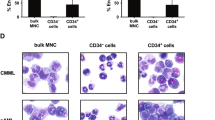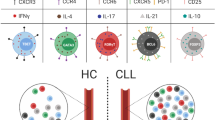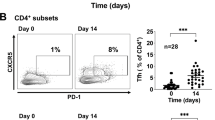Abstract
Chronic lymphocytic leukemia (CLL) is a malignancy of mature B-lymphocytes that manifests in a variety of clinical courses. The accumulation of CLL-cells is primarily caused by defective apoptosis; however, a higher proliferative capacity has also been found to correlate with poorer prognostic factors. Proliferating CLL-cells are confined to specialized structures called pseudofollicles, which contain CLL-cells, T-lymphocytes, and stromal cells. We established an in vitro model for pseudofollicles to characterize the behavior of CLL-cells in relation to clinical courses with different outcomes. Only CLL-cells from progressive clinical cases were inducible to proliferate by a combination of soluble CD40L/IL-2/IL-10 in co-culture with stromal cells. Proliferating CLL-cells showed a higher and more extensive expression of antigens, which are important in T–B-cell interactions such as CD40, MHC II, and adhesion molecules. IL-4 increased interferon regulatory factor-4 expression and induced a specific immunophenotype, which may imply plasmacytic differentiation. Furthermore, it was shown that co-cultured stromal cells protected CLL-cells from apoptosis. CLL-cells from clinically indolent cases had a far worse survival rate in medium than the cells from poor prognostic cases. Thus, we can assume that not only a different resistance to apoptosis, but also proliferation contributes to the progression of CLL resulting in bone marrow failure with thrombocytopenia and anemia.
This is a preview of subscription content, access via your institution
Access options
Subscribe to this journal
Receive 12 print issues and online access
$259.00 per year
only $21.58 per issue
Buy this article
- Purchase on Springer Link
- Instant access to full article PDF
Prices may be subject to local taxes which are calculated during checkout





Similar content being viewed by others
References
Kay NE, Hamblin TJ, Jelinek DF, Dewald GW, Byrd JC, Farag S et al. Chronic lymphocytic leukemia. Hematology Am Soc Hematol Educ Program 2002, 193–213.
Shanafelt TD, Geyer SM, Kay NE . Prognosis at diagnosis: integrating molecular biologic insights into clinical practice for patients with CLL. Blood 2004; 103: 1202–1210.
Rosenwald A, Alizadeh AA, Widhopf G, Simon R, Davis ER, Yu X et al. Relation of gene expression phenotype to immunoglobulin mutation genotype in B cell chronic lymphocytic leukemia. J Exp Med 2001; 194: 1639–1648.
Hamblin TJ, Orchard JA, Ibbotson RE, Davis Z, Thomas PW, Stevenson FK et al. CD38 expression and immunoglobulin variable region mutations are independent prognostic variables in chronic lymphocytic leukemia, but CD38 expression may vary during the course of the disease. Blood 2002; 99: 1023–1029.
Kitada S, Andersen J, Akar S, Zapata JM, Takayama S, Krajewski S et al. Expression of apoptosis-regulating proteins in chronic lymphocytic leukemia: correlations with in vitro and in vivo chemoresponses. Blood 1998; 91: 3379–3389.
Schmid C, Isaacson PG . Proliferation centres in B-cell malignant lymphoma, lymphocytic (B-CLL): an immunophenotypic study. Histopathology 1994; 24: 445–451.
Granziero L, Ghia P, Circosta P, Gottardi D, Strola G, Geuna M et al. Survivin is expressed on CD40 stimulation and interfaces proliferation and apoptosis in B-cell chronic lymphocytic leukemia. Blood 2001; 97: 2777–2783.
Lampert A, Wotherspoon A, van Noorden S, Hasserjian RP . High expression of CD23 in the proliferation centers of chronic lymphocytic leukemia in lymph nodes and spleen. Hum Pathol 1999; 30: 648–654.
Ghia P, Strola G, Granziero L, Geuna M, Guida G, Sallusto F et al. Chronic lymphocytic leukemia B cells are endowed with the capacity to attract CD4+, CD40L+ T cells by producing CCL22. Eur J Immunol 2002; 32: 1403–1401.
Soma LA, Craig FE, Swerdlow SH . The proliferation center microenvironment and prognostic markers in chronic lymphocytic leukemia/small lymphocytic lymphoma. Hum Pathol 2006; 37: 152–159.
Fluckiger AC, Rossi JF, Bussel A, Bryon P, Banchereau J, Defrance T . Responsiveness of chronic lymphocytic leukemia B cells activated via surface Igs or CD40 to B-cell tropic factors. Blood 1992; 80: 3173–3181.
Kitada S, Zapata JM, Andreeff M, Reed JC . Bryostatin and CD40-ligand enhance apoptosis resistance and induce expression of cell survival genes in B-cell chronic lymphocytic leukaemia. Br J Haematol 1999; 106: 995–1004.
Buske C, Gogowski G, Schreiber K, Rave-Fränk M, Hiddemann W, Wörmann B . Stimulation of B-chronic lymphocytic leukemia cells by murine fibroblasts, IL4, anti-CD40 antibodies, and the soluble CD40 ligand. Exp Hematol 1997; 25: 329–337.
Karray S, DeFrance T, Merle-Béral H, Banchereau J, Debré P, Galanaud P . Interleukin 4 counteracts the interleukin 2-induced proliferation of monoclonal B cells. J Exp Med 1988; 168: 85–94.
Dancescu M, Rubio-Trujillo M, Biron G, Bron D, Delespesse G, Sarfati M . Interleukin 4 protects chronic lymphocytic leukemic B cells from death by apoptosis and upregulates Bcl-2 expression. J Exp Med 1992; 176: 1319–1326.
Fluckiger AC, Garrone P, Durand I, Galizzi JP, Banchereau J . Interleukin 10 (IL10) upregulates functional high affinity IL2 receptors on normal and leukemic B-lymphocytes. J Exp Med 1993; 178: 1473–1481.
Kobayashi N, Nagumo H, Agematsu K . IL10 enhances B-cell IgE synthesis by promoting differentiation into plasma cells, a process that is inhibited by CD27/CD70 interaction. Clin Exp Immunol 2002; 129: 446–452.
Messmer BT, Messmer D, Allen SL, Kolitz JE, Kudalkar P, Cesar D et al. In vivo measurements document the dynamic cellular kinetics of chronic lymphocytic leukemia B cells. J Clin Invest 2005; 115: 755–764.
Longo PG, Laurenti L, Gobessi S, Petlickovski A, Pelosi M, Chiusolo P et al. The Akt signaling pathway determines the different proliferative capacity of chronic lymphocytic leukemia B-cells from patients with progressive and stable disease. Leukemia 2007; 21: 110–120.
Jahrsdörfer B, Wooldridge JE, Blackwell SE, Taylor CM, Link BK, Weiner GJ . Good prognosis cytogenetics in B-cell chronic lymphocytic leukemia is associated in vitro with low susceptibility to apoptosis and enhanced immunogenicity. Leukemia 2005; 19: 759–766.
Collins RJ, Verschuer LA, Harmon BV, Prentice RL, Pope JH, Kerr JF . Spontaneous programmed death (apoptosis) of B-chronic lymphocytic leukaemia cells following their culture in vitro. Br J Haematol 1989; 71: 343–350.
Lagneaux L, Delforge A, Bron D, de Bruyn C, Stryckmans P . Chronic lymphocytic leukemic B cells but not normal B cells are rescued from apoptosis by contact with normal bone marrow stromal cells. Blood 1998; 91: 2387–2396.
Pernis AB . The role of IRF4 in B and T cell activation and differentiation. J Interferon Cytokine Res 2002; 22: 111–120.
Nutt SL, Morrison AM, Dörfler P, Rolink A, Busslinger M . Identification of BSAP (Pax-5) target genes in early B-cell development by loss- and gain-of-function experiments. EMBO J 1998; 17: 2319–2333.
Lin KI, Angelin-Duclos C, Kuo TC, Calame K . Blimp-1-dependent repression of Pax-5 is required for differentiation of B cells to immunoglobulin M-secreting plasma cells. Mol Cell Biol 2002; 22: 4771–4780.
Bataille R, Jégo G, Robillard N, Barillé-Nion S, Harousseau JL, Moreau P et al. The phenotype of normal, reactive and malignant plasma cells. Identification of ‘many and multiple myelomas’ and of new targets for myeloma therapy. Haematologica 2006; 91: 1234–1240.
Plander M, Brockhoff G, Barlage S, Schwarz S, Rothe G, Knuechel R . Optimization of three- and four-color multiparameter DNA analysis in lymphoma specimens. Cytometry A 2003; 54: 66–74.
Sciammas R, Shaffer AL, Schatz JH, Zhao H, Staudt LM, Singh H . Graded expression of interferon regulatory factor-4 coordinates isotype switching with plasma cell differentiation. Immunity 2006; 25: 225–236.
Avery DT, Ellyard JI, Mackay F, Corcoran LM, Hodgkin PD, Tangye SG . Increased expression of CD27 on activated human memory B cells correlates with their commitment to the plasma cell lineage. J Immunol 2005; 174: 4034–4042.
Jego G, Bataille R, Pellat-Deceunynck C . Interleukin-6 is a growth factor for nonmalignant human plasmablasts. Blood 2001; 97: 1817–1822.
Stevenson F, Sahota S, Zhu D, Ottensmeier C, Chapman C, Oscier D et al. Insight into the origin and clonal history of B-cell tumors as revealed by analysis of immunoglobulin variable region genes. Immunol Rev 1998; 162: 247–259.
Creery D, Weiss W, Graziani-Bowering G, Kumar R, Aziz Z, Angel JB et al. Differential regulation of CXCR4 and CCR5 expression by interleukin (IL)-4 and IL-13 is associated with inhibition of chemotaxis and human immunodeficiency virus (HIV) type 1 replication but not HIV entry into human monocytes. Viral Immunol 2006; 19: 409–423.
Ghobrial IM, Bone ND, Stenson MJ, Novak A, Hedin KE, Kay NE et al. Expression of the chemokine receptors CXCR4 and CCR7 and disease progression in B-cell chronic lymphocytic leukemia/small lymphocytic lymphoma. Mayo Clin Proc 2004; 79: 318–325.
López-Giral S, Quintana NE, Cabrerizo M, Alfonso-Pérez M, Sala-Valdés M, De Soria VG et al. Chemokine receptors that mediate B cell homing to secondary lymphoid tissues are highly expressed in B cell chronic lymphocytic leukemia and non-Hodgkin lymphomas with widespread nodular dissemination. J Leukoc Biol 2004; 76: 462–471.
Herzog EL, Chai L, Krause DS . Plasticity of marrow-derived stem cells. Blood 2003; 102: 3483–3493.
Stolze B, Ebell W, Welte K . Different binding mechanisms of myeloid leukemic cells to adhesion molecules on bone marrow stromal fibroblasts induced by TNF-alpha and IL-4. Ann Hematol 1998; 77: 265–274.
De Rossi G, Zarcone D, Mauro F, Cerruti G, Tenca C, Puccetti A et al. Adhesion molecule expression on B-cell chronic lymphocytic leukemia cells: malignant cell phenotypes define distinct disease subsets. Blood 1993; 81: 2679–2687.
Tretter T, Schuler M, Schneller F, Brass U, Esswein M, Aman MJ et al. Direct cellular interaction with activated CD4(+) T cells overcomes hyporesponsiveness of B-cell chronic lymphocytic leukemia in vitro. Cell Immunol 1998; 189: 41–50.
Joensuu H, Klemi PJ, Jalkanen S . Biologic progression in non-Hodgkin's lymphoma. A flow cytometric study. Cancer 1990; 65: 2564–2571.
Agrawal SG, Liu FT, Wiseman C, Shirali S, Liu H, Lillington D et al. Increased proteasomal degradation of Bax is a common feature of poor prognosis chronic lymphocytic leukemia. Blood 2008; 111: 2790–2796.
Grdisa M . Influence of CD40 ligation on survival and apoptosis of B-CLL-cells in vitro. Leuk Res 2003; 27: 951–956.
Lundin J, Kimby E, Bergmann L, Karakas T, Mellstedt H, Osterborg A . Interleukin 4 therapy for patients with chronic lymphocytic leukaemia: a phase I/II study. Br J Haematol 2001; 112: 155–160.
Decker T, Hipp S, Ringshausen I, Bogner C, Oelsner M, Schneller F et al. Rapamycin-induced G1 arrest in cycling B-CLL-cells is associated with reduced expression of cyclin D3, cyclin E, cyclin A, and survivin. Blood 2003; 101: 278–285.
Zanesi N, Aqeilan R, Drusco A, Kaou M, Sevignani C, Costinean S et al. Effect of rapamycin on mouse chronic lymphocytic leukemia and the development of nonhematopoietic malignancies in Emu-TCL1 transgenic mice. Cancer Res 2006; 66: 915–920.
Ringshausen I, Peschel C, Decker T . Mammalian target of rapamycin (mTOR) inhibition in chronic lymphocytic B-cell leukemia: a new therapeutic option. Leuk Lymphoma 2005; 46: 11–19.
Meier VS, Rufle A, Gudat F . Simultaneous evaluation of T- and B-cell clonality, t(11;14) and t(14;18), in a single reaction by a four-color multiplex polymerase chain reaction assay and automated high-resolution fragment analysis: a method for the rapid molecular diagnosis of lymphoproliferative disorders applicable to fresh frozen and formalin-fixed, paraffin-embedded tissues, blood, and bone marrow aspirates. Am J Pathol 2001; 159: 2031–2043.
Fais F, Ghiotto F, Hashimoto S, Sellars B, Valetto A, Allen SL et al. Chronic lymphocytic leukemia B cells express restricted sets of mutated and unmutated antigen receptors. J Clin Invest 1998; 102: 1515–1525.
Acknowledgements
This work was supported by grants from both the KAAD (The Catholic Academic Exchange Service) and the BFS (Bavarian Research Foundation). We thank Professor Andreesen, University of Regensburg Medical Center, Institute of Hematology and Oncology, and Professor Kreuser, Barmherzige Brüder Hospital, Regensburg, Oncology and Hematology, for providing the patients' samples. Andrea Sassen is acknowledged for her professional assistance in statistical analysis.
Author information
Authors and Affiliations
Corresponding author
Additional information
The work was done at the University of Regensburg, Regensburg, Germany.
Supplementary Information accompanies the paper on the Leukemia website (http://www.nature.com/leu)
Rights and permissions
About this article
Cite this article
Plander, M., Seegers, S., Ugocsai, P. et al. Different proliferative and survival capacity of CLL-cells in a newly established in vitro model for pseudofollicles. Leukemia 23, 2118–2128 (2009). https://doi.org/10.1038/leu.2009.145
Received:
Revised:
Accepted:
Published:
Issue Date:
DOI: https://doi.org/10.1038/leu.2009.145
Keywords
This article is cited by
-
BCR-associated factors driving chronic lymphocytic leukemia cells proliferation ex vivo
Scientific Reports (2019)
-
Prognostic relevance of CD69 expression in B cell chronic lymphocytic leukemia
Comparative Clinical Pathology (2019)
-
In contrast to high CD49d, low CXCR4 expression indicates the dependency of chronic lymphocytic leukemia (CLL) cells on the microenvironment
Annals of Hematology (2018)
-
Duvelisib treatment is associated with altered expression of apoptotic regulators that helps in sensitization of chronic lymphocytic leukemia cells to venetoclax (ABT-199)
Leukemia (2017)
-
The phosphoinositide-3-kinase (PI3K)-delta and gamma inhibitor, IPI-145 (Duvelisib), overcomes signals from the PI3K/AKT/S6 pathway and promotes apoptosis in CLL
Leukemia (2015)



